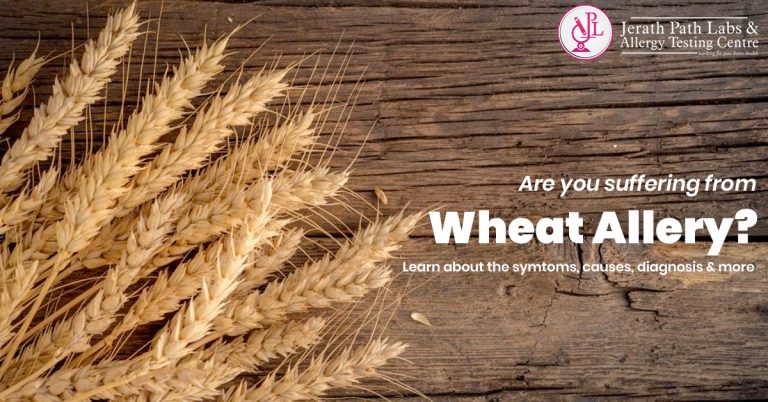Individuals with wheat hypersensitivity have an unusual immune framework reaction to at least one of the proteins present in wheat. Some people have a hypersensitive response when they breathe in wheat flour while eating, which may trigger the manifestations in others.
Exposure to wheat can prompt breathing difficulties, nausea, hives, a bloated stomach, and an inability to focus. In some people, anaphylaxis, a life-threatening allergic response, can occur.
Wheat hypersensitivity is a standout amongst the most widely recognized youth sustenance hypersensitivities. However, it might influence grown-ups, too. An individual with wheat hypersensitivity has developed a particular immune response to a wheat protein. Wheat sensitivity isn’t equivalent to celiac disease.
Causes of Wheat Allergy
A wheat hypersensitivity is an immune framework reaction. When the immune framework mistakes an ordinary or good substance for a pathogen and assaults it, this leads to an unfavourably susceptible response. The immune framework protects us from foreign bodies, pathogens or things that cause illness. These incorporate microorganisms, infections, and toxic substances. Whenever an individual with wheat hypersensitivity eats a protein contained in wheat, their immune framework assaults the protein as though it were a harmful substance, similar to bacteria. An allergen is an innocuous substance to many people, except if they are sensitive to it.
An unfavourably susceptible response to wheat incorporates IgE (immunoglobulin) antibodies responding to at least one of the accompanying proteins found in wheat:
- Albumin
- Globulin
- Gliadin
- Glutenin, or gluten
Some people are sensitive to only one of the proteins in wheat, while others might be oversensitive to two or more.
Signs and Symptoms of Wheat Allergy
A child or grown-up with wheat hypersensitivity will likely exhibit signs and manifestations within minutes to hours after eating something containing wheat. Wheat hypersensitivity indications include:
- Swelling, tingling or aggravation of the mouth or throat
- Hives, irritated rash or swelling of the skin
- Nasal blockage
- Migraine
- Trouble in relaxing
Anaphylaxis Symptoms in Wheat Sensitivity
Wheat sensitivity may cause a hazardous response called anaphylaxis for a few people. Notwithstanding different signs and indications of wheat sensitivity, anaphylaxis may cause:
- Swelling or snugness of the throat
- Chest agony or snugness
- Difficulty in relaxing
- Inconvenience in gulping
- Pale, blue skin colour
- Blacking out
Risk Factors of Wheat Allergy
Certain variables may put you at more serious risk of creating wheat hypersensitivity:
- Family ancestry. You’re at an expanded danger of hypersensitivity to wheat or different sustenance if your parents or siblings have sustenance sensitivities or different hypersensitivities, for example, hay fever.
- Wheat hypersensitivity is most common in infants and babies.
How to Diagnose Wheat Allergy?
- Food Diary: To recognize the cause of the hypersensitivity, a health expert may ask the individual to keep a food diary. This will incorporate notes of everything devoured and detailed notes on manifestations.
- Pinpointing the source: Next, the individual will eliminate all the wheat items from the eating regimen. Following a couple of days, wheat will be reintroduced at interims. The assistance of the food diary can help distinguish which sustenance causes complications. These sustenance can be supplanted with others that don’t cause a response.
Diagnostic Procedures for Food Allergies
This must be done in the presence of a certified well-being proficient.
- Food challenge testing: This is regularly done in an emergency clinic or specific allergy centre. The patient eats foods that contain suspected allergens. They begin with small doses, gradually expanding over hours or days, while the individual is checked for signs and indications.
- Skin-prick test: Drops of diluted sustenances are set on the patient’s arm or back. The skin is then punctured through the drop, introducing the food into the framework. If there is tingling, redness or swelling, the indication is likely a positive response. Notwithstanding, the skin prick test isn’t definitive, so it isn’t used alone for analysis.
- Blood test: This can detect antibodies for specific foods, which shows the probability of a hypersensitivity to those sustenance’s.
Which foods should be avoided?
- Breads and bread crumbs
- Cakes and biscuits
- Cookies
- Breakfast oats
- Pasta
- Hydrolyzed vegetable protein
- Soy sauce
- Meat products
- Dairy items, for example, frozen yoghurt
- Gelatinized starch
If you have wheat hypersensitivity, you may also be susceptible to grain, oats and rye. All the above foods should be avoided if you are allergic to wheat. Peruse the food labels carefully before consuming the outside food.

